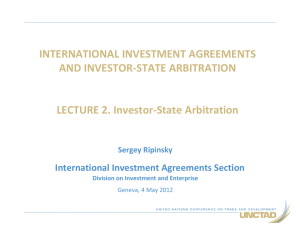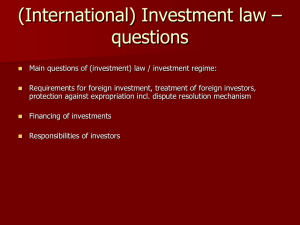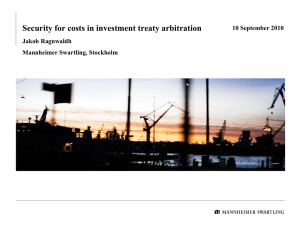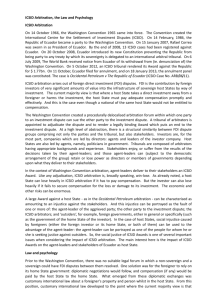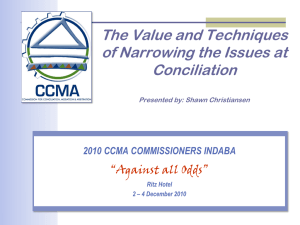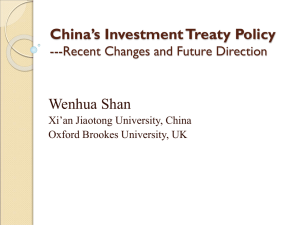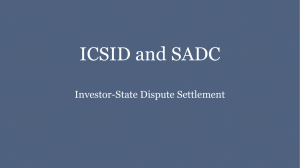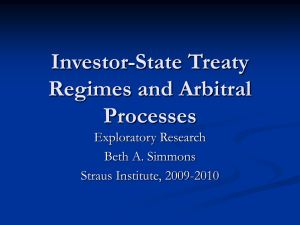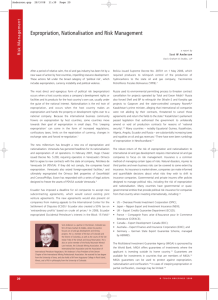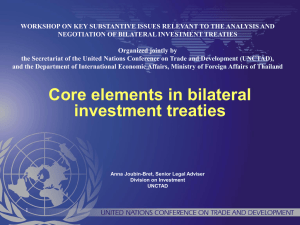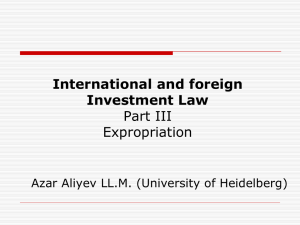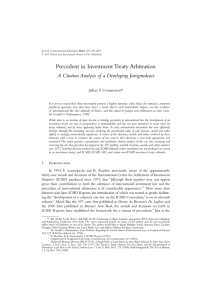recht van de internationale handel
advertisement
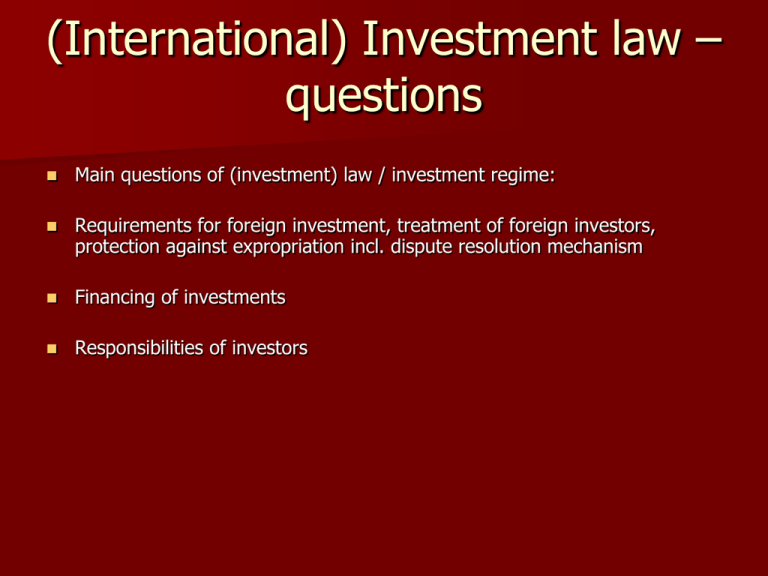
(International) Investment law – questions Main questions of (investment) law / investment regime: Requirements for foreign investment, treatment of foreign investors, protection against expropriation incl. dispute resolution mechanism Financing of investments Responsibilities of investors Investment law - sources - - Sources for rules on foreign investment: National law International Investment Agreements (IIAs), either (mostly) Bilateral Investment Treaties (BIT) (s. infra) or Multilateral treaties (regional, sectorial, TRIMS, world bank treaties) (s. infra) Customary international law, esp. concerning protection in case of expropriation (s. infra) International investment contracts, i.e. contracts between investor and host country, s. next slide Problems of applicable law - - - Why may domestic law (of the host state) be problematic ? protectionism: obligation to buy in the guest country (performance obligations, infra); restrictions on import / export, restrictions on transferring (expatriating) profit , … using sovereignty, eg limited protection against expropriation sometimes also reverse discrimination of nationals, privileges for foreign investors TRIMS 1994: only trade related aspects of investments: Prohibition of quantitative measures and measures with similar effect Principle of national treatment of foreign investment legaly ‘enteed’ Problems of applicable law Can international investment contracts help ? i.e. contracts between investor and host country Contain eg stabilisation clauses (compare infra in BIT) Effectiveness against host country depends on applicable law and competent jurisdiction Applicable law: domestic law or international public law ? quasi international law ? - Dispute resolution mechanism ? most effective is application of international public law and international arbitration Protection ag. expropriation Esp. protection against expropriation Types of expropriation: individual expropriation s.s. (public interest + compensation); collective nationalisation; confiscation; creeping expropriation or quasi-expropriation (disproportionate burdens or restrictions) (lot of disputes as to what amounts to expropriation) Expropriation and international law ? in European countries: 1st Protocol to the ECHR rules of customary public international law ? Next 2 slides - - - Protection ag. expropriation Traditional customary public international law has as rules & conditions for expropriation: - No general prohibition - Allowed only in the public interest (but interpreted thus that poliical purposes are not excluded) - No discrimination of foreigners (unless required for national security) - Effective Prompt Appropriate Compensation (Hull-formula) (i.e. quick, in convertable and exportable currency, full value) - Due process of law (procedural protection) Protection ag. expropriation Traditional customary public international law questioned: by the USSR 1917, Latin Am. (Calvo doctrine), developing countries, …. UN-Resolution no. 1803 from 1962: stresses permanent sovereignty over natural resources of every state (host state for investments) A more radical « Charter of economic rights and duties of States » in 1974 (« new economic order »): NEO-Charter proposed to extend the sovereignty to include all economic activities, does not require « public interest », grants only « reasonable » compensation, refuses international procedural control, etc. Such expropriations will however not be recognised by other countries Thus not accepted as customary law, meanwhile slipped into oblivion (Reaction after 1974’s: BIT’s) - - Investment treaties Uncertainty about the customary international public law creates need for treaties Next slides: multilateral treaties; bilateral treaties Foundation of 2 new institutions under the world bank: - ICSID 1965 - MIGA 1985 Bilateral Inv. Treaties (BIT) Bilateral investment treaties (BIT) (also known as Foreign Investment Promotion and Protection Agreements, FIPAs) BIT’s in response to the NEO-Charter - Starting in 1959 with Germany-Pakistan almost 3000 BIT’s (57 with Belgium, ca. 130 with Germany, etc.) (more specifically end of 2013: 2857 BIT’s and 339 other agreements with an investment dimension) Big countries have a model BIT Sometimes followed by a larger FTA (China-Switzerland FTA 2014, supplementing the 2010 BIT) Some countries are terminating their BIT’s, eg South Africa (BIT w. Benelux, Germany, Spain)(«Black Economic Empowerment »); Indonesia; Bolivia & Ecuador left ICSID Others limit the scope of the dispute settlement, eg Australia (included in 2013 safeguards in areas as public health, welfare and environment) has predictive qualities in an area with such ample opportunities for rational BIT’s learning, it will almost certainly also have it with respect to other policies. Figure 1.1. The spread of BITs Bilateral investment treaties, 1959-2009 300 3000 250 2500 200 2000 150 1500 100 1000 50 500 0 0 1959 1964 1969 1974 1979 Total (2nd axis) Source: UNCTAD 1984 1989 1994 1999 Annual 2004 2009 Bilateral Inv. Treaties (BIT) Fate of « Extra-EU-BIT’s » after Lisbon Treaty: Reg. 1219/2012 - EU intends to replace national extra-EU-Bits’ by common EU-BIT’s. Duty of MS’s to eliminate incompatibilities As it is often sufficient to invest via a company incoporated under the laws of a country with a BIT, investors form third countires may use this indirect way. Scope of application (usually): (inward) investment, usually broadly defined (FDI = foreign direct investment) Sometimes restricted to certain investments or under certain conditions - Multilateral Investm. Treaties OECD: OECD 1967 Draft Convention on the Protection of Foreign property failed; OECD-MiA failed; negotiations on a GIT in WTO failed FTAs (Free Trade Agreements) contain also investment protection, as in: NAFTA Ch. 11: non-discrimination; investor chooses dispute resolution Mercosur COMESA CETA (EU / Canada Partnership, 2013), EU-Singapore FTA Oct 2014 (EUSFTA concluded, not signed yet) Negotiations on other FTA’s, such as TTIP and TPP (but no investment chapter in the 2009 EU-Korea FTA) (EU: internal market as a more radical solution) Other Regional IT’s, such as: Investments agreement of the OIC (Bagdad 1981); ASEAN Comprehenisve Investment Agreement (ACIA) 2009, … Sectorial: Energy Charter Treaty 1994, infra Also investment aspects in Cotonou (EU / ACP), supra TRIMS, supra Codes of conduct of the World Bank, OECD, « UN Global Compact »,… World bank related treaties, infra Energy Charter Treaty - - - Sectorial Multilateral investment treaties ? Sectorial Energy Charter Treaty 1994, in force 1998 45 countries from Europe (incl. EU itself), former Soviet U + Japan; (Russia withdrew in 2009; Norway and Australia did not ratify) Oil & electricity; Concerns investment / exploitation / transport; Principle of non-discrimination Protection against expropriation and quasi-expropriation Dispute resolution mechanism (arbitration) for breaches of Part II ECT. Investor may choose arbitration according to ICSID, Uncitral or SCC (Stockholm) E.g. Procedures by Vattenfall v. Germany (i.a. decision to close nuclear plants) E.g. Arbitration Youkos v. Russia (initiated while Russia was still bound by the ISDS) Energy Charter Treaty Bilateral Inv. Treaties (BIT) Typical content (1) Freedom to invest ? (free inflow and outflow of capital) Usually not fully liberalised Usually no full national treatment, but a MFN clause + minimum standard of «proper & equitable» treatment Incl. often prohibition of ‘performance requirements’ (such as requirement of « national » content of products …) (conflicts with EU quota rules) Protection of investments made: Stabilisation clauses (later regulation cannot negatively affect the investment); observance clauses (later regulations not applicable); also called ‘umbrella clause’ (giving an umbrella to certain obligations). Purpose: turn a contractual obligation (which can often be overruled by national public law or change in legislation) into an international obligation validity (binding character) sometimes disputed Usually rules on protection in case of expropriation Capital transfer guarantees (free movement of capital, ‘free transfer of payment’) (some conflicts with EU law) Foreign investment – financing institutions - - « Project financing » through international institutions International lenders (financing institutions) An important player is the World bank: comprises 5 institutions: IBRD (1944) (188 members): loans for projects (usually in cooperation with banks) to states, with funds from member states or capital markets, short term and on interest; no flow-back to funding states: neutral assessment – annual reports IDA (1960): advantageous loans for least developed countries: long term, no or very low interest IFC (International Finance Corporation, 1956): loans or capital investment in private sector; technical assistance and advice MIGA (Multilateral Investment Guarantee Agency 1985): see infra ICSID (1965): mediation and arbitration institution, infra. IBRD MIGA - MIGA (Multilateral Investment Guarantee Agency) 1985: mainly covers noncommercial risks of investors from MIGA-member countries in other MIGAcountries; succesful (168 members) Coverage can be granted by MIGA after assessment of risks if: An investment is made (interpreted widely) By an investor from a MIGA-country After the granting of the guarantee (only new investments) In a developing country, member of MIGA Contributing to development Approval by the host country is required; usually MIGA will contract with the country to limit the risks Risks that can be covered: mainly 4 types: currency transfer restrictions; expropriation and similar measures; breach of contract without domestic remedy; sometimes war and civil disturbance. Not: eg devaluation Conditions will be specified in a contract MIGA-investor: premium to be paid; uninsured percentage (usually 10 %), arbitration clause Disputes between MIGA-states on the Convention: submitted to Board of MIGA Disputes MIGA - host country: negotiation; if necessary arbitration Other financing institutions Other international lenders (financing institutions) Regional development banks - often on condition of flow-back to funding countries: African DB, Asian DB (67 members, strong Japanese influence), Inter-American DB, new AIIB (Asian Infrastructure Investment Bank, 2014, strong Chinese influence).... EBRD (European Bank for reconstruction and Development) – for Eastern Europe; 65 memebrs, capital mainly from EU countries, US, Canada, Japan Investment Funds of the EU: - ACP countries (Cotonou agreement): investment facilities - EU-internal: European Investment Bank (projects for regional development) - European Social Fund UN-organisations, esp. UNDP Responsibilities of investors Some elements in investment treaties, Free Trade Agreements etc. Codes of conduct of the World Bank, OECD, « UN Global Compact »,… Conditions imposed by financing institutions Esp. the performance standards of the IFC. They concern: Assessment of environmental and social risks Labor and working conditions Resource efficiency and pollution prevention Community health, safety and security Land acquisition and involuntary resettlement Biodiversity conservation and living natural resources Indigenous peoples Cultural heritage - S. also the OECD guidelines for multinational enterprises - Reporting obligations for big companies, eg in EU Non-financial reporting directive: report annually on social matters, human rights, ani-corruption mesaures Dispute resolution (in BITs) - - - Renegotiation clauses Arbitration clauses: Arbitration may be under the ICSID rules (infra) or under UNCITRAL rules (see Ch. 12). Sometimes subject to a national court requirement (eg UK-Argentina BIT: first go to the Argentinian court; if no decision within 18 months arbitration is open) The UNCITRAL rules impose a certain degree of ‘transparency’ (public access for third parties to hearings and documents except confidential or protected information), but this applies only a) to arbitration under BIT’s concluded after April 1, 2014 or b) when parties agree. Under ICSID, access is much more limited (discretionary decision of the tribunal) 2014 UNCITRAL Draft Convention on Transparency in treaty-based investorState arbitration (for existing BIT’s) Question whether an arbitration clause in a BIT displaces a forum clause in the investment contract itself: concurrent jurisdiction*, or priority of one clause over the other ? (*ICSID arb 97/3 Compania de Aguas del Aconquija) ICSID Investment treaty arbitration ICSID – Convention 1965: dispute resolution procedure for investment disputes now 150 ratifications (+ 9 signatures); became much more important since the 1990’s. Canada ratified Nov 2013 (after solving federalism problem). Missing Russia (not ratified), i.a. India, Brazil, South Africa (not signed); Withdrawal by Ecuador, Bolivia, Venezuela. Scope of application: only investment disputes between a party to the ICSID Convention and an investor from another contracting party (or a local daughter company)* jurisdiction of the ICSID has been accepted in an investment contract, domestic law, BIT or ad hoc ICSID organises the procedure, does not settle the dispute itself conciliation procedure (not succesful) arbitration procedure no «seat»; annulment procedure organised by ICSI itself * Dispute whether still possible under intra-EU BIT’s (according to EU Commission, contrary to 344 TFEU; not according to Frankfurt Court) Investment treaty arbitration Advantages of ICSID –Arbitration If a choice of law was made in the contract, the arbitrators must apply that law But national law can be set aside if contrary to public international law (art. 42 ICSID) Arbitral award can be set aside only by ICSID itself, not by a national court; limited grounds for annulment Exclusive jurisdiction; national courts lose jurisdiction; no immunity of jurisdiction for ICSID states before ICSID Member states recognise the awards as binding and guarantee the enforcement within their territory; nevertheless enforcing often remains difficult « Additional facility »: ICSID assistance in cases out of the scope of application of the Convention (eg investor not a national of an ICSID State) (but awards are then not falling under the ICSID Convention bu unde rthe NY Convention or arbitration) Awards are published in annual Reports Criticism: no guarantees for fair trial & impartiality, no public character*, no guarantee of consistent interpretation by a single tribunal, etc… * unless Uncitral Transparency rules apply
